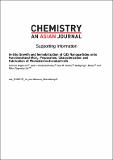Por favor, use este identificador para citar o enlazar a este item:
http://hdl.handle.net/10261/195712COMPARTIR / EXPORTAR:
 SHARE SHARE
 CORE
BASE CORE
BASE
|
|
| Visualizar otros formatos: MARC | Dublin Core | RDF | ORE | MODS | METS | DIDL | DATACITE | |

| Título: | In-situ growth and immobilization of CdS nanoparticles onto functionalized MoS2: preparation, characterization and fabrication of photoelectrochemical cells |
Autor: | Kagkoura, Antonia; Hernández-Ferrer, Javier CSIC ORCID; Benito, Ana M. CSIC ORCID ; Maser, Wolfgang K. CSIC ORCID ; Tagmatarchis, Nikos | Palabras clave: | Transition metal dichalcogenides Quantum dots Functionalization Hybrids Photoelectrochemical cells Electron transfer Nanoparticles |
Fecha de publicación: | 26-nov-2019 | Editor: | Wiley-VCH | Citación: | Chemistry - an Asian Journal 15(15): 2350-2356 (2020) | Resumen: | A facile strategy for the controllable growth of CdS nanoparticles at the periphery of MoS 2 en route the preparation of electron donor‐acceptor nanoensembles is developed. Precisely, the carboxylic group of α‐lipoic acid, as addend of the modified MoS 2 obtained upon 1,2‐dithiolane functionalization, was employed as anchor site for the in‐situ preparation and immobilization of the CdS nanoparticles in an one‐pot two‐step process. The newly prepared MoS 2 /CdS hybrid material was characterized by complementary spectroscopic, thermal and microscopy imaging means. Absorption spectroscopy was employed to register the formation of MoS 2 /CdS, by observing a broad shoulder centered at 420 nm due to CdS nanoparticles, while the excitonic bands of MoS 2 were also evident. Moreover, based on the efficient quenching of the characteristic fluorescence emission of CdS at 725 nm by the presence of MoS 2 , strong electronic interactions at the excited state between the two species within the ensemble were identified. Photoelectrochemical assays of MoS 2 /CdS thin‐film electrodes revealed a prompt, steady and reproducible anodic photoresponse during repeated on‐off cycles of illumination. A significant zero‐current photopotential of ‐540 mV and an anodic photocurrent of 1 μA were observed, underlining improved charge‐separation and electron transport from CdS to MoS 2 . The superior performance of the charge‐transfer processes in MoS 2 /CdS is of direct interest for the fabrication of photoelectrochemical and optoelectronic devices. | Descripción: | 2 Esquemas, 5 Figuras.-- This is the pre-peer reviewed version of the following article: "In-situ growth and immobilization of CdS nanoparticles onto functionalized MoS2: preparation, characterization and fabrication of photoelectrochemical cell", Chemistry - an Asian Journal: 2019, which has been published in final form at https://doi.org/10.1002/asia.201901371. This article may be used for non-commercial purposes in accordance with Wiley Terms and Conditions for Use of Self-Archived Versions". | Versión del editor: | http://dx.doi.org/10.1002/asia.201901371 | URI: | http://hdl.handle.net/10261/195712 | DOI: | 10.1002/asia.201901371 | ISSN: | 1861-4728 | E-ISSN: | 1861-471X |
| Aparece en las colecciones: | (ICB) Artículos |
Ficheros en este ítem:
| Fichero | Descripción | Tamaño | Formato | |
|---|---|---|---|---|
| PREPRINT_CHEMASIANJOURNAL_AKagkoura_MoS2-CdS.pdf | Artículo principal | 581,45 kB | Adobe PDF |  Visualizar/Abrir |
| asia201901371-sup-0001-misc_information.pdf | Información suplementaria | 553,07 kB | Adobe PDF |  Visualizar/Abrir |
CORE Recommender
SCOPUSTM
Citations
4
checked on 30-abr-2024
WEB OF SCIENCETM
Citations
5
checked on 23-feb-2024
Page view(s)
225
checked on 07-may-2024
Download(s)
351
checked on 07-may-2024
Google ScholarTM
Check
Altmetric
Altmetric
NOTA: Los ítems de Digital.CSIC están protegidos por copyright, con todos los derechos reservados, a menos que se indique lo contrario.
